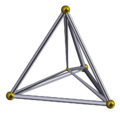| Rectified 5-cell | ||
 Schlegel diagram with the 5 tetrahedral cells shown. | ||
| Type | Uniform 4-polytope | |
| Schläfli symbol | t1{3,3,3} or r{3,3,3} {32,1} = | |
| Coxeter-Dynkin diagram | ||
| Cells | 10 | 5 {3,3} 5 3.3.3.3 |
| Faces | 30 {3} | |
| Edges | 30 | |
| Vertices | 10 | |
| Vertex figure |  Triangular prism | |
| Symmetry group | A4, [3,3,3], order 120 | |
| Petrie polygon | Pentagon | |
| Properties | convex, isogonal, isotoxal | |
| Uniform index | 1 2 3 | |

In four-dimensional geometry, the rectified 5-cell is a uniform 4-polytope composed of 5 regular tetrahedral and 5 regular octahedral cells. Each edge has one tetrahedron and two octahedra. Each vertex has two tetrahedra and three octahedra. In total it has 30 triangle faces, 30 edges, and 10 vertices. Each vertex is surrounded by 3 octahedra and 2 tetrahedra; the vertex figure is a triangular prism.
Contents
- Wythoff construction
- Structure
- Semiregular polytope
- Alternate names
- Images
- Coordinates
- Related 4-polytopes
- Compound of the rectified 5-cell and its dual
- Pentachoron polytopes
- Semiregular polytopes
- Isotopic polytopes
- Notes
- References
- External links
Topologically, under its highest symmetry, [3,3,3], there is only one geometrical form, containing 5 regular tetrahedra and 5 rectified tetrahedra (which is geometrically the same as a regular octahedron). It is also topologically identical to a tetrahedron-octahedron segmentochoron.[ clarification needed ]
The vertex figure of the rectified 5-cell is a uniform triangular prism, formed by three octahedra around the sides, and two tetrahedra on the opposite ends. [1]
Despite having the same number of vertices as cells (10) and the same number of edges as faces (30), the rectified 5-cell is not self-dual because the vertex figure (a uniform triangular prism) is not a dual of the polychoron's cells.

















































































